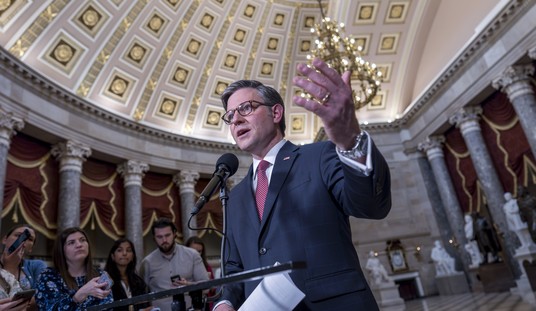In 1977, President Jimmy Carter warned Americans of a pending "national catastrophe" in a prime time nationally televised speech. "The Oil and natural gas we rely on for 75 percent of our energy are running out." Resources were being depleted so fast that the world "could use up all the proven reserves of oil in the entire world by the end of the next decade," Carter said.
Rather obviously, Carter's end-of-the-world-as-we-know-it prediction didn't happen.
Had Carter been right, by now much of the agenda of the radical environmentalists would have been a fait accompli. Weaning America off oil, natural gas, and coal to heat our homes, power our cars, and run our factories would have taken care of itself due to a scarcity of the resources. But, Carter was wrong – dramatically wrong.
Since America and the World didn't run out of fossil fuel resources shortly after Carter made his doomsday prediction, the anti-oil, gas, and coal crowd lead by Al Gore moved on to the threats of global warming claiming we were doomed to drown from rising seas created by global warming. The culprit again was fossil fuels, of course. Much of that prediction has been debunked or at least greatly minimalized, too.
Instead of running out of oil and gas as Carter predicted, the inventory of America's recoverable domestic reserves has increased dramatically. During the past three decades, scientists and energy industry experts continued to improve techniques to harvest known reserves and discover new ones. A Congressional Research Service report to Congress in late 2009 indicated that America's combined supply of recoverable natural gas, oil, and coal exceeds every other nation on earth; even far greater than Saudi Arabia, China, and Canada combined!
The CRS report was independently confirmed last month by the Institute for Energy Research with the release of the North American Energy Inventory. The IER study says the U.S. has more than 1.4 trillion barrels of recoverable oil reserves; 1.7 trillion barrels when combined with Canada and Mexico. That's enough for 250 years of U.S. consumption according to the IER, and more than the entire world has used in the previous 150 years.
Additionally, the North American continent has 4.2 quadrillion cubic feet of recoverable natural gas reserves – enough to last the next 175 years at current rates of consumption according to IER. Once upon a time, back in the days of Jimmy Carter, the environmentalists were encouraging more usage of natural gas as the "clean" alternative to coal and oil. However, that has grown out of fashion with the go-green purists including Barack Obama, who prefer to funnel hundreds of millions of taxpayer dollars into pie-in-the-sky green energy boondoggles like Solyndra while discouraging and even eliminating oil and gas production at every opportunity.
Since we didn't run out of oil and gas, and the whole global warming thing stalled, the latest fear-strategy adopted by the radical environmentalists is to attack the technology – hydraulic fracturing – that is behind our ability to harvest the massively greater amounts of energy resources.
Hydraulic Fracturing – or "fracking" – has greatly expanded the recoverable reserves of oil and gas. Fracking has been used since the 1940s in over a million wells, and the technology continues to be improved and refined.
As defined by The Geological Society of America, fracking involves pumping liquids down a well into subsurface rock units under pressures that are high enough to fracture the rock, creating a network of interconnected fractures that will serve as pore spaces for the movement of the oil and natural gas to the well bore to be lifted to the surface.
When combined with horizontal drilling, fracking has turned previously unproductive reserves into some of the most abundant fields in the world such as the Marcellus formation in Pennsylvania, the Bakken in North Dakota, and the Niobrara in Colorado, Wyoming, Nebraska, and Kansas. (See a brief animated demonstration of hydraulic fracturing here.)
In recent years, environmentalists have relentlessly attacked fracking claiming it might cause groundwater contamination, even though in virtually all cases the fracking is done hundreds or thousands of feet below ground water levels. And, since few people have even a slight understanding of the geology or the technology, public perception is easily influenced and the media is often a willing co-conspirator in fanning the hysteria.
To be sure, there is some risk involved with fracking as with any mechanical process. However, when asked directly during a Senate Committee hearing in May, 2011 even EPA Administrator Lisa Jackson testified that she was "not aware of any proven case where the fracking process itself has affected water." Jackson came to the EPA with a well established reputation as an environmental activist and has pursued that agenda aggressively at the agency. Other EPA officials have previously offered the same testimony to Congress.
Still, the radical left's quest continues with a public relations war raging against fracking technology. Jackson's EPA is moving forward toward new federal regulations, even in the face of heavy pushback from states that historically regulated energy development operations within their borders.
The liquids used in the fracking process are virtually all water and sand mixtures – as much as 99.5% according to published reports. The Geological Society of America explains that the small amount of chemicals are used to thicken the water into a gel that is more effective at opening fractures, reduce friction, prevent corrosion of equipment, control pH, and kill bacteria. "Proppants" – usually aluminum or ceramic beads – are also added to "prop opened" the fractures once the fluids are removed so the oil and gas can escape. Until recently, energy companies have guarded their formulas as proprietary secrets, but public pressure and new regulation are causing them to make public their ingredients.
That ground water can be and has been contaminated is a given, and in many cases, fingers have been pointed at the energy industry and specifically at fracking technology. But, as EPA Administrator Jackson admitted, in spite of scores of investigations, there is no scientific evidence linking any ground water contamination to fracking. But, that doesn't stop some in the Obama Administration from pushing their agenda forward to satisfy a core constituency.
In west-central Wyoming, the small town of Pavillion has complained about water quality and possible contamination for years. In fact, the U.S. Geological Survey detected organic chemicals in Pavillion's well water 50 years ago, long before any fracking was done in the area. But, when somebody suggested the water quality problems might be linked to the gas wells the EPA jumped in and started a study three years ago.
On December 8, 2011 the EPA published a "draft report" of findings suggesting that there may be a connection to Pavillion's water problems and fracking. Why the agency chose to publish a report that had not been subjected to independent peer review or even by state officials in Wyoming is a question that answers itself. "The agency is dominated by anticarbon true believers, and the Obama Administration has waged a campaign to raise the price and limit the production of fossil fuels," opined the Wall Street Journal. Environmentalists and many in the media rejoiced – and the movement got the headlines they longed for:
EPA Lowers the Boom on Fracking in Wyoming
EPA Finds Hydrofracking Chemicals Contaminate Drinking Water
Gas-Fracking Chemicals Detected in Wyoming Aquifer, EPA Says
EPA says 'fracking' probably contaminated well water in Wyoming
The Governor of Wyoming, Matt Mead, was quick to respond and he certainly should have both the health of his citizens and the state's industry paramount in his mind. On the day the EPA report was released, Mead called it "scientifically questionable" and said more and better testing was needed before anyone could reach a definitive conclusion. Most concerning to Gov. Mead was that the EPA based their conclusions "on data from two test wells (not operating water wells) drilled in 2010 and tested once that year and once in April, 2011. Those test wells are deeper than drinking wells," the Gov. said, causing him and others to wonder how the EPA could reach their conclusion.
Mead had appointed a working group to study the Pavillion problem that included local residents, state agencies, Indian Tribes, the EPA and the BLM. But, the EPA didn't even make their report available to the rest of the group until shortly before releasing it to public. A highly critical house editorial in the Casper Star-Tribune on Dec. 26 said, "…process and politics have trumped good science…The EPA's process-oriented almost ho-hum approach does a disservice to Wyoming whose residents need answers about their water, and whose economy hinges on the safe and successful practice of fracking."
In a feature editorial, the Wall Street Journal stated the obvious, that everybody wants clean drinking water. "But we also need to be sure that regulators aren't spreading needless fears so they can enhance their own power while pursuing an ideological agenda." The WSJ summarized many of the same questions and concerns that Gov. Mead and others have raised about the EPA report:
Recommended
- The EPA study concedes that "detections in drinking water wells are generally below [i.e., in compliance with] established health and safety standards." The dangerous compound EPA says it found in the drinking wells was 2-butoxyethyl phosphate. The Petroleum Association of Wyoming says that 2-BE isn't an oil and gas chemical but is a common fire retardant used in association with plastics and plastic components used in drinking wells.
- The pollution detected by the EPA and alleged to be linked to fracking was found in deep-water "monitoring wells"—not the shallower drinking wells. It's far from certain that pollution in these deeper wells caused the pollution in drinking wells. The deep-water wells that EPA drilled are located near a natural gas reservoir. Encana Corp., which owns more than 100 wells around Pavillion, says it didn't "put the natural gas at the bottom of the EPA's deep monitoring wells. Nature did."
- To the extent that drilling chemicals have been detected in monitoring wells, the EPA admits this may result from "legacy pits," which are old wells that were drilled many years before fracking was employed. The EPA also concedes that the inferior design of Pavillion's old wells allows seepage into the water supply. Safer well construction of the kind normally practiced today might have prevented any contaminants from leaking into the water supply.
- The fracking in Pavillion takes place in unusually shallow wells of fewer than 1,000 to 1,500 feet deep. Most fracking today occurs 10,000 feet deep or more, far below drinking water wells, which are normally less than 500 feet. Even the EPA report acknowledges that Pavillion's drilling conditions are far different from other areas of the country, such as the Marcellus shale in Pennsylvania. This calls into question the relevance of the Wyoming finding to newer and more sophisticated fracking operations in more than 20 states.
Of the EPA's report, the Star-Tribune said, "If it's not sloppy science, it's poor policy." And, the editors go on to make the damning accusation that "the Pavillion study is not about science, (but) about politics."
For an administration committed to perverted energy policies that drive fossil fuel prices higher in hopes that increased energy costs will make green-energy more attractive, all this increased oil and gas production creates a real problem. Just last week the press was reporting that because of increased supplies, natural gas prices fell to their lowest level in over two years. You might think that lower consumer costs would be well received at the White House, but not in an administration committed to implementing policies to get America's energy prices "to the levels in Europe," as Energy Secretary Steven Chu admits.
Interior Secretary Ken Salazar has banned drilling on millions of acres of federal land. Oklahoma Senator Jim Inhofe says 83 percent of all federal land is already off-limits for energy development, and Salazar is constantly adding more. Where he can't ban it, he makes it ever more difficult to get leases and permits to drill. Legislation passed by Congress in 2005 reaffirmed that Congress wanted the states, not the federal government, to regulate gas drilling, but that doesn't stop this administration. As mentioned above, the EPA wants to muscle the states out of the way, and assert federal control and restrict fracking. The Pavillion report helps them make their case. North Dakota Governor Jack Dalrymple says the proposed EPA rules restricting fracking "would have huge economic impact on our state's energy development. We believe strongly this should be regulated by the states."
That more is in play with the Pavillion report than just clean water for 160 Wyoming residents is pretty obvious. Steve Forbes says the Obama Administration is repeating all the mistakes of the Carter Administration's failed energy policies, and has already established "the most anti-oil and gas record in U.S. history." While there may eventually be proven some connection between gas wells and water contamination in Pavillion, we have to wonder if the Administration hadn't already reached a conclusion about fracking and the energy industry, and was just looking for a convenient excuse to help them make the case.
Tom Doll is the Supervisor of the Wyoming Oil and Gas Conservation Commission, and as such is the state's top regulator. Doll is also a native of Wyoming, graduate of the University of Wyoming as a petroleum engineer, and has more than three decades of field experience in the industry. According to Doll, the contamination EPA found in the Pavillion monitoring wells could be explained by natural causes or by the EPA because of the way the agency drilled, completed and tested the wells. "We really raised a lot of questions, provided four pages of questions on the monitoring wells: How they were drilled and completed, how they were sampled," Doll told the Casper Star-Tribune. Those questions were submitted to the EPA on Nov. 22, less than two weeks after the state and the Pavillion working group got a look at the draft report, but 16 days before the EPA released it to the public. "We posed all those questions to the EPA and they haven't gotten answers back yet on those concerns," Doll said.
As a candidate for President, Obama pledged that good science would guide policy in his Administration, but his actions belie his words. He says he's for jobs and for economic recovery, yet he dithers on approval of the Keystone Pipeline. Obama claims that, "Last year…oil production from federal waters in the Gulf of Mexico reached an all-time time high," but his own energy department reports production in the Gulf is down by 300,000 barrels per day after his misguided moratorium. He spews the radical left's lie that "we only have 2 percent" of the world's energy reserves when numerous government and independent reports prove America has vast resources if only our government would let them be harvested.
My dad often warned me about people who "would say one thing, but do another." That's the kind of President and Administration that is in Washington now. So, if you heard Barack Obama last month at a press conference say that his administration is "all in" for domestic energy production; believe just the opposite. Expect more debilitating, delaying, costly regulation. Expect more federal land and off-shore reserves to be put off-limits. Expect more "sloppy" reports like Pavillion designed to move a political agenda. And, expect billions more of borrowed dollars to be squandered on false green-gods like Solyndra in order to mollify and reward his political cronies. This isn't about science, and it isn't about good government. It's just politics; Obama style.

























Join the conversation as a VIP Member